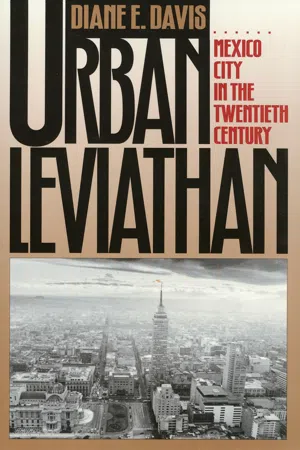
- English
- PDF
- Available on iOS & Android
About This Book
Why, Diane Davis asks, has Mexico City, once known as the city of palaces, turned into a sea of people, poverty, and pollution? Through historical analysis of Mexico City, Davis identifies political actors responsible for the uncontrolled industrialization of Mexico's economic and social center, its capital city. This narrative biography takes a perspective rarely found in studies of third-world urban development: Davis demonstrates how and why local politics can run counter to rational politics, yet become enmeshed, spawning ineffective policies that are detrimental to the city and the nation.
The competing social and economic demand of the working poor and middle classes and the desires of Mexico's ruling Partido Revolucionario Institutional (PRI) have led to gravely diminished services, exorbitant infrastructural expenditures, and counter-productive use of geographic space. Though Mexico City's urban transport system has evolved over the past seven decades from trolley to bus to METRO (subway), it fails to meet the needs of the population, despite its costliness, and is indicative of the city's disastrous and ill-directed overdevelopment. Examining the political forces behind the thwarted attempts to provide transportation in the downtown and sprawling outer residential areas, Davis analyzes the maneuverings of local and national politicians, foreign investors, middle classes, agency bureaucrats, and various factions of the PRI.
Looking to Mexico's future, Davis concludes that growing popular dissatisfaction and frequent urban protests demanding both democratic reform and administrative autonomy in the capital city suggest an unstable future for corporatist politics and the PRI's centralized one-party government.
Frequently asked questions
Information
Table of contents
- Contents
- List of Abbreviations
- Preface and Acknowledgments
- 1. Laying the Foundations
- 2. The Urban Terrain of Postrevolutionary State Building, 1910- 1929
- 3. Mexico City Governance and the Move Toward Corporatism, 1929-1943
- 4. Balancing Party Sectors Through Urban Administration, 1944-1958
- 5. The PRI at the Crossroads: Urban Conflict Splits the Party, 1958-1966
- 6. Rethinking Mexico City's Role in National Development, 1966- 1973
- 7. From Urban to National Fiscal Crisis, 1973-1982
- 8. Urban Democratic Reform as Challenge to Corporatist Politics, 1982-1988
- 9. Recasting the Dynamics of Urban and Political Change in Mexico
- Appendixes
- Notes
- Bibliography
- Index